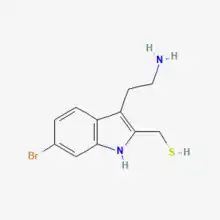BrMT
BrMT (6-bromo-2-mercaptotryptamine) is a neurotoxin found in the hypobranchial gland of the marine snail species Calliostoma canaliculatum. The disulfide-bond-linked dimer of BrMT is found to possess inhibitory effects on voltage-gated potassium channels of the Kv1 and Kv4 family.
 | |
| Names | |
|---|---|
| IUPAC name
[3-(2-Aminoethyl)-6-bromo-1H-indol-2-yl]methanethiol | |
| Other names
6-Bromo-2-mercaptotryptamine | |
| Identifiers | |
3D model (JSmol) |
|
PubChem CID |
|
| |
| |
| Properties | |
| C11H13BrN2S | |
| Molar mass | 285.20 g·mol−1 |
Except where otherwise noted, data are given for materials in their standard state (at 25 °C [77 °F], 100 kPa).
Infobox references | |
Source
BrMT was first isolated from the mucus of Calliostoma canaliculatum, a cone snail found in the temperate coastal waters of the western Pacific. BrMT is the first compound found in the hypobranchial gland mucus to produce a biological response.[1]
Chemistry
BrMT is a brominated betaine and is a non-peptide neurotoxin produced by Calliostoma canaliculatum. The inhibition of the opening of voltage-gated potassium channels is produced by the sulfide-linked dimer of BrMT. The monomer has no effect on Kv1 and Kv4 voltage-gated potassium channels. The dimer is formed by the coupling of the thiol groups in BrMT, producing the sulfide-linked dimer of BrMT.[1] BrMT is found to be light-sensitive and unstable in a reducing environment. Its first full synthesis was described in 2013.[2]
Target
Calliostoma canaliculatum primarily uses yellow mucus containing BrMT to deter predators by covering their shells with this mucus when exposed to a predator, such as Pycnopodia helianthoides and Pisaster giganteus naturally found predators of the Calliostoma canaliculatum.[3]
The BrMT dimer is known to affect potassium voltage-gated ion channels in the central nervous system. It is known to strongly inhibit the ShBΔ potassium channels, and in less degree isoforms from human (hKv1.1) and squid (sqKv1.A). It also affects members of Kv4 family (Kv4.1 and Kv4.2) and Drosophila ether-à-go-go channels.[1]
Mode of action
The mode of action of BrMT involves its inhibition of specific potassium voltage gated ion channels which are found in the nervous system of an organism. By stabilizing the resting voltage sensor in the ion channel, the opening of ShBΔ ion channels and other Kv1 members are inhibited.[2] BrMT has as IC50 of 1.1 ± 0.1 μM on ShBΔ channels a member of the Kv1 family.[4] The BrMT binding to ShBΔ has been found to be allosteric in nature, due to a change of conformation in the K channel subunits and not by blocking the entrance of the channel.[4][5]
References
- Kelley, Wayne P.; Wolters, Andrew M.; Sack, Jon T.; Jockusch, Rebecca A.; Jurchen, John C.; Williams, Evan R.; Sweedler, Jonathan V.; Gilly, William F. (September 2003). "Characterization of a Novel Gastropod Toxin (6-Bromo-2-mercaptotryptamine) That Inhibits Shaker K Channel Activity". Journal of Biological Chemistry. 278 (37): 34934–34942. doi:10.1074/jbc.m301271200. ISSN 0021-9258. PMID 12815055.
- Gao, Detian; Sand, Rheanna; Fu, Hao; Sharmin, Nazlee; Gallin, Warren J.; Hall, Dennis G. (2013-10-15). "Synthesis of the non-peptidic snail toxin 6-bromo-2-mercaptotryptamine dimer (BrMT)2, its lower and higher thio homologs and their ability to modulate potassium ion channels". Bioorganic & Medicinal Chemistry Letters. 23 (20): 5503–5506. doi:10.1016/j.bmcl.2013.08.070. ISSN 0960-894X. PMID 24021461.
- Bryan, Patrick J.; Mcclintock, James B.; Hamann, Mark (1997-03-01). "Behavioral and Chemical Defenses of Marine Prosobranch Gastropod Calliostoma canaliculatum in Response to Sympatric Seastars". Journal of Chemical Ecology. 23 (3): 645–658. doi:10.1023/B:JOEC.0000006401.97339.b9. ISSN 1573-1561. S2CID 951925.
- Dockendorff, Chris; Gandhi, Disha M.; Kimball, Ian H.; Eum, Kenneth S.; Rusinova, Radda; Ingólfsson, Helgi I.; Kapoor, Ruchi; Peyear, Thasin; Dodge, Matthew W.; Martin, Stephen F.; Aldrich, Richard W.; Andersen, Olaf S.; Sack, Jon T. (2018-05-08). "Synthetic Analogues of the Snail Toxin 6-Bromo-2-mercaptotryptamine Dimer (BrMT) Reveal That Lipid Bilayer Perturbation Does Not Underlie Its Modulation of Voltage-Gated Potassium Channels". Biochemistry. 57 (18): 2733–2743. doi:10.1021/acs.biochem.8b00292. ISSN 0006-2960. PMC 6007853. PMID 29616558.
- Sack, Jon T.; Aldrich, Richard W. (2006-06-26). "Binding of a Gating Modifier Toxin Induces Intersubunit Cooperativity Early in the Shaker K Channel's Activation Pathway". The Journal of General Physiology. 128 (1): 119–132. doi:10.1085/jgp.200609492. ISSN 1540-7748. PMC 2151558. PMID 16801385.